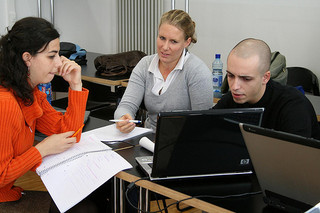At its simplest, Micro-research (also known as Inquiry-based Learning) involves getting students to undertake a relatively small research project and report back to their peers. The purpose of the approach is to encourage students to develop a deeper understanding of the material they have been researching while also developing skills that will be useful for other parts of the study and their eventual careers, such as critical thinking and evaluation, communication and presentation skills and information literacy skills. The approach challenges students to move towards becoming independent and autonomous learners by requiring them to find their own answers, rather than relying on their tutors supplying the necessary information.
How it Works

“UFV Student Research Day” by University of the Fraser Valley
Typically a Micro-research activity would involve the students either being assigned or choosing a topic and undertaking a brief, but systematic, investigation into it before eventually presenting their findings in some way to their peers. Through this approach, the students learn both as part of their research and also through being questioned about their findings by their peers. This explicit interaction with their peers at the end of the process makes Micro-research an excellent way to introduce students to other learning approaches, such as critiquing and debate.
The approach is very flexible and can be adapted to fit many different situations and, in particular, different timescales and research scope. For example, students could be given a research task at the beginning of a lecture or seminar and be expected to present something back to the rest of the class by the end of it. Another example might be where students are given several weeks to research a topic and then present a poster to their peers about their findings, in fact, one of the first modules that History students at SHU take when joining the institution involves researching a topic related to Sheffield and presenting their findings at a poster session that is open to the public. The approach is also adaptable in other ways, including whether the students work on their own or as a group, whether they can choose their own topic, and the type of output that they will produce and share with their peers (such as a presentation, poster, video, ebook, website, etc.) Micro-research is particularly appropriate to the Pecha Kucha presentation method, which places an emphasis on clarity and brevity of communication.
The eventual artifact (poster, presentation, etc.) that the students produce can be used by them as an example of their work when applying for jobs and further study. However, providing appropriate permission has been obtained, it can also form the basis of learning materials for other students to either build on or use in their own studies.
Possible Technologies to Support the Approach
The flexibility of the approach means that there are many different technologies that can be used. There are technologies to help with the research element of the activity, such as Resource Lists Online, Google Scholar, library databases and social media tools such as Twitter and Facebook. There are also many tools that will assist students in sharing their findings, such as presentation software, online infographic creation tools, wikis, desktop publishing packages, content curation sites, eBook creation packages and Google Docs or Sites. The choice of tools is partly dependent on the subject that the students will be researching and partly on the practicalities of assessment, but it is generally a good idea to allow the students to select the specific tools that they will use. This means specifying the type of output that is expected, such as a poster, website, presentation, etc., rather than the tool itself.

“200810 051” by smannion
With such a variety of tools available, it is important to consider the skills that students are going to develop through the activity. For example, in courses where students will be giving lots of presentation it may be a better development experience for them to produce a poster as this will help them develop a different set of technical and communications skills. When introducing technology into this approach it is essential to explain the reasoning behind the selection of particular tools and state the useful skills that the students will be developing as part of the process.
Getting Started
If you are interested in trying out Micro-research there are a few practical questions that you should answer:
- Where in the course would this approach work best?
- How long would the students have to conduct their research?
- Would this be part of the students’ formal assessment?
- Which topic areas would the students most benefit from investigating?
- What formats would be most appropriate for sharing their findings? What formats will most challenge the students to develop?
- How much technology should be involved? Which tools are most suited? What support would be needed?
- Are the students (and other tutors) ready for this?
Having thought about these questions, you should have worked out whether Micro-research is an approach that makes sense in your context and have some ideas about how to introduce it. If you are still unsure, you could try a very small, in-session Micro-research activity and see how the students respond.
Further Resources
Case studies from SHU:
The following links are to case studies showing how staff at SHU have used Micro-research ideas in their teaching:
- Developing learning literacies with digital posters – Diane Rushton
- Encouraging learner autonomy through small, self-selected research projects – Chris Corker & Sarah Holland
- Promoting learner autonomy through media production and presentations – Mike Bramhall
Related ‘Teaching Nuggets’:
The following links provide further information on some activities and assessment outputs that can work well with Micro-research tasks, especially for students who are part-time or not campus-based:
Other resources:
- Self-discovery learning – E-Learning Faculty Modules
- All About Linguistics – University of Sheffield
- ‘Menu’ of Teaching Approaches – Sheffield Hallam University


